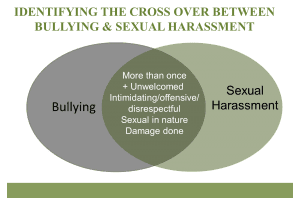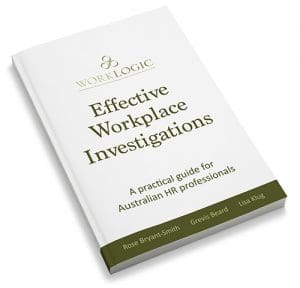I recently presented Worklogic’s first lunchtime webinar, discussing the cross-over between workplace bullying and sexual harassment, recent cases and the key lessons for managers keen to mitigate against this type of people risk. You can watch this webinar on-demand for free if you missed it!
 There were five key takeaways from this session:
There were five key takeaways from this session:
- Inappropriate behaviour can be both sexual harassment and bullying
- Examine and consider what is being reported against all your policies, values and codes of conduct
- Be clear about “jokes” at work and the place of social media
- Do you have a more systemic problem? If you have a toxic culture of exclusion, “talk to the top”
- Conduct refresher training now.
There were also a lot of interesting questions raised in the interactive Q&A afterward that I have shared below:
One of the first slides referred to the overlap between sexual harassment and bullying. Could we look at the differences between these issues particularly in the context of how the courts would review / identify these behaviours?
There are many choices for where an employee can seek redress for inappropriate workplace behaviour. In summary, there may be complaints lodged under state or federal Equal Opportunity laws, at anti-discrimination agencies, or via the Fair Work Act (2009) Clth at Fair Work Australia, including for orders to ‘stop the bullying’. There may be common law claims for negligence or breach contract, and Worksafe authorities may also explore criminal prosecution if there is a physically or psychologically unsafe workplace.
Can directors or senior managers be personally liable for the company’s action/omission in this area?
Yes. Directors and senior managers can be liable under a range of laws (Workplace Health and Safety), EO, Fair Work, common law negligence, contract) for failing to provide safe and healthy workplaces, acting or assisting in discriminatory behaviour or victimising employees who raise concerns.
What can you/should you do if the problem is at the top of the business?
If the problem is at the top of the business, in terms of either bullying or sexually harassing behaviour (or condoning such behaviours by others), then you need to explore what information and approach will best resonate for those individuals. A few questions may assist you with how you plan the type of information and approach, such as:
- Do/does the individuals/individual in question have any insight into their behaviour? (or, try asking “How might they feel if their behaviour was all over the Herald Sun?”)
- Are they aware of their legal obligations under a range of jurisdictions?
- Do they understand how their behaviour impacts on others in the workplace, and on a range of other risks too, including (in no particular order), financial risk, legal risk, psychological risk, reputational risk?
- What is your leverage? Are you a valued counsellor? Will you be listened to?
Depending on the answers, you will then be able to ascertain if you are able to have a frank conversation about the risks to the business by the demonstrated behaviour, and depending on levels of insight, explore how to improve individual behaviour and the culture as a whole. If the person/people at the top are not ‘walking the talk’, then you will probably have a culture that is not, and that will also then need some further interventions.
How do you achieve saturation of the zero-tolerance message across the organisation?
In order to properly and consistently ensure that you get this message out of zero tolerance for bullying and sexual harassment, firstly you need key support of the CEO, executive level managers, the board and/or those is in a position of authority. These people need to demonstrate public commitment, and to also support this message wherever they can.
Ensure that your values, codes of conduct, contracts of employment and KPIs support the message. Your recruitment, induction and training must all ensure that staff understand their rights and responsibilities as to how they act in the workplace towards each other.
There also needs to be a key focus on how managers manage: do they ‘walk the talk’, know how to have effective conversations, respond to conflict and inappropriate behaviour. Explore how you know how your culture is tracking: have regular culture reviews and introduce a concerns reporting line/online service if you don’t have these already as part of how you identify what else can be done to further improve your culture.
How do you turn around a culture that has tolerated sexual innuendo and jokes?
Identify where that tolerance is occurring. Is it ‘a few bad apples’ or all pervasive? You may need to start at the top. Certainly, you need to identify whether there needs to be targeted or across the board training on what is expected of all staff, and why. Such training needs to be sophisticated, engaging and dynamic. It should be more than just ‘here’s the law’, it needs to explore the aims and benefits of creating a highly professional workplace environment. It also needs to deal with any pushback around “you can’t take a joke”, or “this is political correctness gone mad.”
If an employee refuses to document allegations, are employers still obligated to investigate given it is unclear of what the concerns of the employee are?
You will need to triage how serious the allegation is. If the allegation were to be investigated and there was proven behaviour, would that proven behaviour contravene your policies, and/or relevant laws? If so, you have an obligation to minimise the risk to health and safety and that would mean conducting an ‘organisation led’ investigation. At the very least, depending on what is alleged, you may need to undertake an investigation, mediation and/or workplace review. Take home message: triage, and act (and usually investigate) accordingly.
What are your thoughts upon explaining to employees from the outset of the receipt of their grievance that even if proven, that the conduct would not likely meet the threshold of certain labels (such as bullying or harassment)?
Yes, do explore and explain this. Transparency is key. This conversation you would have with the employee is about exploring what is the most appropriate and effective way of responding to their concerns. If the matter is not one that falls within the definition of bullying or sexual harassment, and you are clear and confident about this, then you need to identify what will be the best path forward. Refresher training for the group, a facilitated discussion (or mediation), or a review may all be useful and relevant options.
Can you talk about the role of investigations both by internal or external agencies. Time taken? and implemented actions?
Investigations can be conducted internally or externally. Questions of risk (who is involved, how serious is it) and resources (do internal staff have the time/skills/perception of impartiality) will determine if a matter is best investigated externally.
Where Worklogic is engaged to investigate (instead of the HR team), can you outline what steps are involved and how extensive the matter may be in terms of time frame and cost?
Worklogic has been conducting external workplace investigations into allegations of workplace misconduct for the past ten years. No two investigations take the same amount of time, and vary in scope enormously. In our experience, procedurally fair, reliable and effective investigations take weeks not days. Beyond that, it is not possible to give a definitive answer regarding how long an investigation will last.
In relation to implemented actions, our investigation reports will make findings of fact, and if requested, a comment, on any allegations that are proven, on any apparent breach of policies.
We typically charge by the hour and, of course, provide an estimate for any matter. This is determined based on the number of allegations, number of witnesses and t he scope of the brief and sets out how much every step of the investigation is likely to cost.
he scope of the brief and sets out how much every step of the investigation is likely to cost.
Read more about our approach to conducting workplace investigations.
What is the name of the investigations book you were referring to?
Worklogic’s Effective Workplace Investigations book is the definitive guide to conducting effective workplace investigations for Australian HR professionals. Effective Workplace Investigations shows you, step-by-step, how to conduct a sound, procedurally fair and defensible workplace investigation.
Written by myself and fellow Co-Founder Rose Bryant-Smith, and Worklogic Senior Investigator, Lisa Klug, our Effective Workplace Investigations book is an essential reading for anyone with responsibility for investigating workplace conflicts or complaints.
About Grevis Beard
 Grevis Beard is the co-founder and director of Worklogic. From his career as a barrister and solicitor and his specialisation in discrimination law, Grevis has significant knowledge of the dynamics of workplace disputes and their resolution. Grevis works with a range of clients to improve workplace communication, manage workplace risks, handle complaints and improve employee behaviour.
Grevis Beard is the co-founder and director of Worklogic. From his career as a barrister and solicitor and his specialisation in discrimination law, Grevis has significant knowledge of the dynamics of workplace disputes and their resolution. Grevis works with a range of clients to improve workplace communication, manage workplace risks, handle complaints and improve employee behaviour.
Worklogic works with employers to resolve workplace complaints and create a positive culture at work. We can help you develop a powerful framework for appropriate behaviour at work. We also deliver interactive on-site training programs to help your staff become supportive bystanders, challenge mindsets and to reinforce your values.

